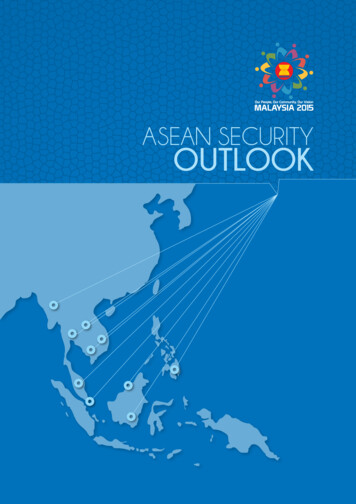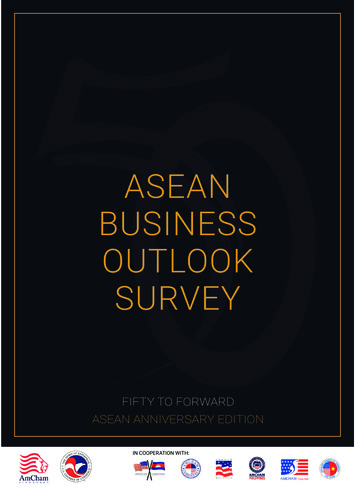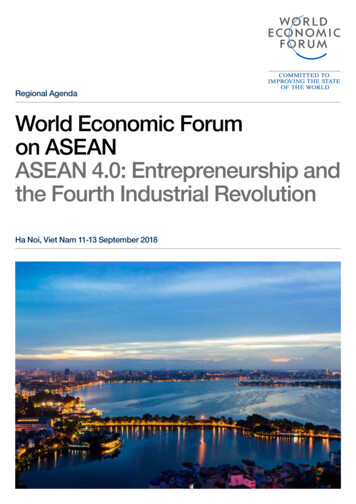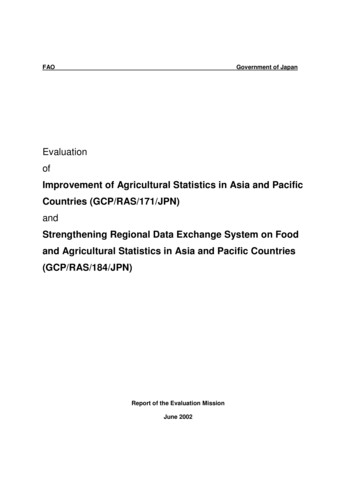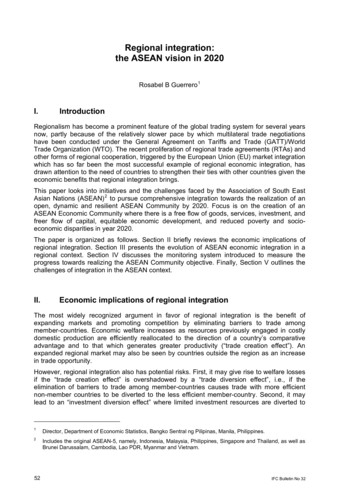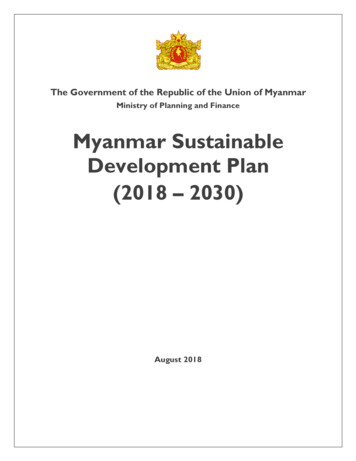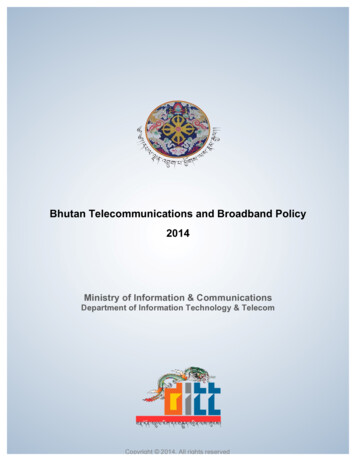
Transcription
EndorsedASEAN TELECOMMUNICATIONS AND INFORMATIONTECHNOLOGY MINISTERS MEETING (TELMIN)FRAMEWORK ON DIGITAL DATA GOVERNANCEBackground and Overview1.ASEAN as a regional group has been experiencing sustained economic growth.With the right elements in place such as good and robust infrastructure, soundand progressive policies and governance frameworks, ASEAN’s potential forgrowth is tremendous. To achieve this growth, it would be critical to boosteconomic integration and technology adoption across all sectors in the tenASEAN Member States1 (referred to collectively as “ASEAN Member States” orindividually as “ASEAN Member State”).2.Globally, there have been significant efforts to harmonise data standards, datagovernance or data protection frameworks, such as the OECD Guidelines onthe Protection of Privacy and Transborder Flows of Personal Data, APECPrivacy Framework, EU General Data Protection Regulation (EU-GDPR) andStandards for Personal Data Protection for Ibero-American States. To keeppace, ASEAN needs to develop forward-looking and enabling frameworks andpolicies that facilitate the growth of the digital economy. There is also a need tostrengthen the governance of digital data in ASEAN with a view to promotingthe growth of trade and flow of data within and among ASEAN Member Statesin the digital economy. Progress on digital data management issues also varyconsiderably across ASEAN and there is significant opportunity to improvetransparency on requirements and identify areas to enhance performance.23.In this respect, the Heads of State of ASEAN Member States have jointlyreaffirmed the importance of maintaining ASEAN centrality and unity in itscommunity-building efforts, and have agreed on key deliverables for ASEANsuch as Cybersecurity cooperation and personal data protection, and promotinginnovation and e-commerce.3 The Master Plan on ASEAN Connectivity 2025has also identified the development of an ASEAN Framework on Digital DataGovernance (referred to as the “Framework”) as an initiative that is intended toenhance data management, facilitate harmonisation of data regulations amongASEAN Member States4 and promote intra-ASEAN flows of data. This helps toensure that ASEAN, collectively, realises the potential benefits, even with therecognition that the ten ASEAN Member States are currently at different levelsof maturity.1The term ASEAN Member States refers to Brunei Darussalam, the Kingdom of Cambodia, the Republic ofIndonesia, the Lao People’s Democratic Republic, Malaysia, the Republic of the Union of Myanmar, the Republicof the Philippines, the Republic of Singapore, the Kingdom of Thailand, and the Socialist Republic of Viet Nam.2 Master Plan on ASEAN Connectivity 2025 Project Concept – Concept Note Initiative 7 – Establish an ASEANDigital Data Governance Framework, 15 August 2017.3 Chairman’s Statement of the 32nd ASEAN Summit, Singapore, 28 April 2018.4 Building on the ASEAN Framework on Personal Data Protection adopted in 2016.1
EndorsedObjectives4.This Framework sets out the strategic priorities, principles and initiatives toguide ASEAN Member States in their policy and regulatory approaches towardsdigital data governance (which include both personal and non-personal data) inthe digital economy. These are summarised in Figure 1.Figure 1 – Summary of the ASEAN Framework on Digital Data GovernanceScope of the Framework5.The Framework identifies four strategic priorities of digital data governance thatsupport the ASEAN digital economy, namely:(a)(b)(c)(d)6.Data Life Cycle and Ecosystem;Cross Border Data Flows;Digitalisation and Emerging Technologies; andLegal,Regulatory and Policy.The Framework also identifies four initiatives that can be undertaken in supportof the four strategic priorities, which are:(a)(b)(c)(d)ASEAN Data Classification Framework;ASEAN Cross Border Data Flows Mechanism;ASEAN Digital Innovation Forum; andASEAN Data Protection and Privacy Forum.2
Endorsed7.This Framework will not apply to:(a)Measures adopted by an ASEAN Member State to exempt any areas,persons or sectors from the application of the Principles identified underthe Framework; and(b)Matters relating to national sovereignty, national security, public safety,and all government activities deemed suitable by an ASEAN MemberState to be exempted.ASEAN Guiding Principles on Data Governance for the Digital Economy(“Principles”)8.The Principles for each strategic priority aim to provide ASEAN Member Stateswith guidance to develop data governance for the digital ecosystem based oneach ASEAN Member State’s level of readiness and development.9.Each ASEAN Member State will endeavour to take into account and implementwithin their domestic laws and regulations the Principles in accordance with thisFramework. Where relevant, each ASEAN Member State should alsoencourage organisations to consider or incorporate these Principles whendeveloping policies and practices.Strategic Priority 1: Data Life Cycle and Ecosystem10.The Principles on the data life cycle and ecosystem highlight the importance ofdata governance at every stage of the data life cycle and how that cancontribute to the overall integrity and usability of data. The data life cycle followsthe various stages of data management – from the point when the data isgenerated or collected for specific functions or purposes, to the data being used(e.g. processed and analysed), including when the data is in transit or at restand through to the final point where the data is eventually deleted.A.11.Principle on Data Integrity and TrustworthinessThe Principle on data integrity and trustworthiness recognises that access toaccurate and reliable data is critical, especially when the data is used to analyseand support business decisions such as product development, service deliveryor market expansion. This would include:(i)Tracking and documenting data sources to account for when data isprocured externally or generated internally;(ii)Ensuring data accuracy, where practicable, over the entire data life cycleby implementing good data management practices, including manageddata collection and creation, proper data recording and processing suchthat it does not affect the data quality, review and update internaldatabases to ensure data is up-to-date especially when the data is usedto make a decision about individuals, and incorporate safeguards fordata storage; and3
Endorsed12.13.(iii)Promoting interoperability of standards by ensuring that data provided isin a structured, commonly used and machine-readable format.B.Principle on Data Use and Access ControlThe Principle on data use and access control promotes accountability in dataprocessing, which is a key component in data governance. This would include:(i)Using and/or processing data only for purposes that are reasonable andappropriate; and which are not contrary to laws or national policies;(ii)Assigning different access controls and levels of authorisations topersonnel for access to different types or classifications of data; and(iii)Ensuring that access to data should be adequate, relevant, andtransparent.C.Principle on Data SecurityThe Principle on data security establishes the need to safeguard data, and anystorage centres the data sits within, as well as the systems and platforms thathandle the data. This would include:(i)Taking appropriate measures, including technical, procedural andphysical measures, to ensure that they protect the confidentiality,integrity and availability of any data in their possession, or control againstrisks such as loss or unauthorised access, use, modification, disclosure,or destruction; and(ii)Addressing data breaches promptly and effectively, by containing thebreach and implementing mitigating measures to rectify the breach andwhere relevant, in accordance with national policies on data breachnotifications.Initiative under Strategic Priority 1: ASEAN Data Classification Framework14.Data governance principles on data life cycle and ecosystem may differdepending on, among other things, the types of data. The level of protectionrequired and accorded under the Principles may apply the same approach andconsiderations. For example, certain types of data (e.g. sensitive personaldata) require higher levels of protection, such as by having stricter accesscontrols or more stringent handling and disclosure requirements compared todata that is publicly available.15.To afford data the necessary and adequate level of protection, it will be usefulto have a common data classification framework, which sets out broadcategories of data, descriptions of what each category entails and developmentof security requirements for each data classification level.4
Endorsed16.The data classification framework is not meant to be an exhaustive or bindinglist of data categories. Each category of data will include recommendedmeasures or protections that should apply to that specific category of data.These include steps that can be taken to allow data to be processed, shared ortransferred across country borders. The factors that could be considered for thedevelopment of the data classification framework include data sensitivity, riskassessment, protection impact management, storage and storage standards,or applicable industry regulations and standards.Strategic Priority 2: Cross Border Data Flows17.Data is regarded as the lifeblood of the digital economy, driven by increasingtechnology adoption and digitalisation. As the region moves towards aborderless, interconnected environment, the Principle on cross border dataflows is intended to guide governments, businesses and consumers in theregion as they navigate their way through managing data flows in this newphase of digital transformation and integration.18.Data flows should be accompanied by assurances that safeguards are in placeto protect and secure the information regardless where the data goes. Thesesafeguards should be harmonised to prevent the development of fragmentedregulatory regimes, which may negatively impact data flows and increasebusiness compliance costs.19.It should be emphasised that not all requirements imposed on cross border dataflows are detrimental to the economy. Requirements may exist to ensure thatthere are safeguards to accord the necessary protection for the data beingtransferred. It is important for individual ASEAN Member States to review andminimise restrictions5 to cross border data flows against the backdrop of itsoverall impact to data innovation and the goal of fostering a vibrant dataecosystem.D.20.Principle on Cross Border Data FlowsThe Principle on cross border data flows is intended to maximise the free flowof data within ASEAN to foster a vibrant data ecosystem but at the same timeensure that the data transferred is accorded the necessary protection. Thiswould include:(i)Facilitating cross-border data flows within ASEAN by developing clearand unambiguous requirements and/or criteria and/or circumstances inwhich data can be transferred from one ASEAN Member State toanother;(ii)Evaluating and ensuring that the requirements on cross border dataflows within ASEAN are proportionate to the risks associated with5Restrictions may come in the form of policies requiring organisations to store data within the country (e.g. datalocalisation), or regulatory conditions imposed before data can flow out of the country of origin (e.g. consent of theindividual, for purposes of fulfiling contractual obligations).5
Endorsedtransferring the data, taking reference from the data classificationframework; and(iii)Building trust by ensuring an adequate level of protection is accorded tothe transferred data.Initiative under Strategic Priority 2: ASEAN Cross Border Data Flow Mechanism21.Increased data flows promote innovation and collaboration. However, for thesebenefits to materialise, businesses need regulatory certainty on who they mayshare data with, the types of data that may be shared, and how they may sharesuch data. A cross border data flow mechanism within ASEAN is expected tofacilitate such data flows between participating ASEAN Member States.22.While specifics of the mechanism will need to be worked out, the mechanismwill take into account the different levels of maturity and local laws present inthe ASEAN Member State. ASEAN Member States may then assess theirparticipation in the mechanism when they are ready to do so.Strategic Priority 3: Digitalisation and Emerging Technologies23.It is important for ASEAN Member States to identify and leverage emergingtechnologies and the latest trends, including the benefits these technologiescan offer. Capacity building is an important part of this, and an economy willonly be able to develop itself as a digital economy if it has access to welldeveloped infrastructure and a skilled workforce. These two elements oftenfeed off each other to produce digital solutions and generate significantsynergies, including in the promotion of cross-border data transfers.E.24.Principle on Capacity DevelopmentThe Principle on capacity development advocates capacity building andequipping stakeholders with the necessary resources to evolve with the newtrends and technologies. This would include:(i)Undertaking regular stakeholder engagements and consultationsessions to assess and put in place basic and next-level supportstructures to develop and sustain the digital infrastructure in the short,medium and long-terms;(ii)Facilitating universities and learning institutions in updating theircurricula and pedagogic approaches in educational and vocationaltraining to equip and empower the current and future workforce withrelevant data and digital skills;(iii)Encouraging organisations, especially micro, small and mediumenterprises, to conduct regular on-the-job training for employees; and(iv)Encouraging cooperation and aid on human capacity development,information exchanges between ASEAN Member States, as well as with6
Endorsedinternational organisations to reduce the digital divide between ASEANMember States.Initiative under Strategic Priority 3: ASEAN Digital Innovation Forum25.Given the pace at which technological innovation and advancement isoccurring, some firms in traditional sectors, small and medium enterprises, andeven government agencies grapple with keeping abreast of the latesttechnological developments and emerging technologies. As technologies havethe potential to help businesses streamline their operations and drive growth,productivity and innovation, there is significant value in knowledge sharing andtransfer between technology firms, ASEAN Member States that have adoptedsuch technologies, with other ASEAN Member States.26.ASEAN should establish a digital innovation forum to create avenues forbusinesses of all sizes from ASEAN to share the latest technologicaldevelopments. The forum functions as an avenue for effective dissemination ofinformation on emerging digital trends and the relevant regulatory issues. Suchforums can also include hands-on workshops for participants to experiment withthe latest technological solutions, and to motivate them to adopt newtechnologies. Ideally, these forums would encourage collaboration betweentechnology firms and other private and public sector organisations, promotedata-driven innovation and improve awareness on key issues such ascybersecurity in ASEAN.Strategic Priority 4: Legal,Regulatory and Policy27.A harmonised legal and regulatory digital data environment within ASEAN playsa vital role in generating business confidence and stimulating economic growth.While there are a few key pieces of legislation that form the foundation of digitaleconomies, a particular area of focus is on the development and harmonisationof personal data protection regulations, building on the ASEAN Framework onPersonal Data Protection.F.Principle on Personal Data Protection and Privacy Regulation28.The Principle on personal data protection and privacy regulation establishes theneed for harmonisation of personal data protection regulations within ASEAN.ASEAN Member States should endeavour to work towards establishingpersonal data protection regulations in their respective countries.29.In the absence of country-specific personal data protection regulation, anypolicies established sectorally may refer to the Principles set out in the ASEANFramework on Personal Data Protection, including Consent, Notification andPurpose, Accuracy of Personal Data, Security Safeguards, Access andCorrection, Transfers to Another Country or Territory, Retention andAccountability.7
EndorsedG.30.31.Principle on AccountabilityThe Principle on accountability requires the development and implementationof data protection and data management policies and guidelines. This wouldinclude:(i)Data protection and data management policies that are clearlydocumented and communicated with relevant stakeholders; and(ii)Continuous review of data protection and data management policies totake into account relevant emerging technologies and trends, and tomake amendments as necessary to maintain currency.H.Principle on Development and Adoption of Best PracticesThe Principle on development and adoption of best practices recognises thenon-binding nature of the Framework, and encourages ASEAN Member Statesto promote adherence with these principles. ASEAN Member States shouldendeavour to encourage domestic adoption of measures that give effects to thePrinciples in this Framework.Initiative under Strategic Priority 4: ASEAN Data Protection and Privacy Forum32.ASEAN Member States can establish an annual ASEAN Data Protection andPrivacy Forum to facilitate knowledge sharing and discuss the implementationdetails of the four proposed initiatives under this Framework, whether theASEAN Member State has an established data protection authority orotherwise.33.The ASEAN Data Protection Forum can facilitate the sharing of knowledge andoperational know-how by policy makers and regulators, which will help ASEANMember States that do not have a personal data protection authority in settingup their respective authorities. It can also discuss, among other things, issuessuch as enforcement cooperation, considerations when dealing with multiplestakeholders in data protection enforcement cooperation.Effect of the Framework34. This Framework is non-binding, and does not create rights or obligations underdomestic or international law for the ASEAN Member States.Implementing the Framework35.To facilitate the implementation of this Framework, including the proposedinitiatives, ASEAN Member States should endeavour to provide regular biannual updates on their progress of implementing the Framework at the workinggroup level. This will enable ASEAN Member States to monitor theirdevelopment with respect to this Framework.8
Endorsed36.Thereafter, following the establishment of the annual ASEAN Data ProtectionForum, ASEAN Member States may provide milestone updates at this Forum.Amendments37.This Framework may be reviewed periodicially, and amended at any time toincorporate new developments or changes, by mutual agreement amongst allASEAN Member States.ADOPTED AT Bali, Indonesia, this sixth day of December in the year two thousandsand eigthteen in one (1) original copy in the English language.9
innovation and e-commerce.3 The Master Plan on ASEAN Connectivity 2025 has also identified the development of an ASEAN Framework on Digital Data Governance (referred to as the "Framework") as an initiative that is intended to enhance data management, facilitate harmonisation of data regulations among
